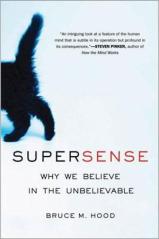Read the whole interview.Are We Born Believers or Cultural Receivers? A Discussion with Author and Psychologist Bruce Hood
Few topics in psychology are gaining more momentum than the origin of religious beliefs. Questions of whether we’re born with neural apparatus that predisposes us to belief, or whether we learn to becomes believers, or some combination of both, are on the minds of researchers from all quarters. Bruce Hood, experimental psychologist at Bristol University, is a groundbreaker among the curious. In his new book, SuperSense: Why We Believe in the Unbelievable, Hood argues that we are each born with an innate “SuperSense” rooted in our capacity for intuitive reasoning. Drawing on recent research and historical examples, Hood convincingly makes a case that supernatural belief arises spontaneously well before cultural influences assert themselves.
I recently spent a few minutes with Professor Hood discussing his SuperSense theory and other topics from his book.
DiSalvo: What is the “SuperSense”?
Hood: The SuperSense is a set of related beliefs that there are hidden dimensions to reality manifesting as energies, patterns and forces accounting for paranormal claims and experiences.
How would you describe these “hidden dimensions to reality”?
People infer from their experience that there are hidden forces, energies and entities operating in the world. From luck to God, people think there are hidden elements.
The main argument of the book is stated as, “Children generate knowledge through their own intuitive reasoning about the world around them, which leads to both natural and supernatural beliefs.” Do children arrive at supernatural beliefs entirely before culture makes an imprint on their developing minds? If that’s true, then what’s the role of culture, to provide content for these beliefs?
Not entirely. Rather, children are inclined to those beliefs from culture which resonate with what they believe could be possible. For example, pre-school children do not understand death as a final state. When they are told that something has died they want to know where it has gone, so after-life beliefs either from religion or paranormal accounts are readily accepted.
However, if there was no culture to feed the children with after-life beliefs then the SuperSense theory predicts that such notions would arise spontaneously. What we need is a “Lord of the Flies” scenario to test this prediction but the fact that after-life beliefs are present in all cultures strongly suggests that this is a universal belief.
You discuss the history of supernaturalism and mention a couple of surprising examples: one is the “lion-man” statuette that dates to 32,000 years ago, and another is evidence of ritualistic burials dating back 45,000 years. What do these examples tell us about our species’ supernatural leanings?
The lion-man statuette found in Germany is a therianthrope – part human part animal. Many of the early religions dealt with such mythical creatures and possibly reflect early man’s pre-occupation with hunting and how to improve success by appeasing the animal gods. This is still present in a number of remaining hunting societies such as the Inuits.
I also think that it is no coincidence that therianthropy resembles young children’s early anthropomorphism which is to attribute human properties to animals, though I neglected to cover this in SuperSense. The early emergence of these beliefs, including ritualistic burials, in the dawn of civilization across differing groups strongly suggests that they are part of our mental machinery.
Tags:


No comments:
Post a Comment